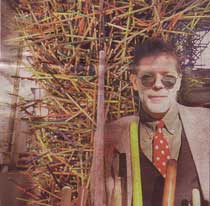
I’m sad to report that Brian Wagner, found-object sculptor and media arts faculty at Drexel, died suddenly at his home Friday. Wagner, 59, was suffering from cancer. He was a gentle soul and a gifted artist and someone I profiled for an article at the Weekly early on in my art writing career when he put his “5,000 Sticks” sculpture in the old trolley barn on 41st and Haverford in West Philadelphia.
Mark Campbell, a friend of Wagner’s emailed to let me know the sad news as did Christine Cassidy, another friend. Campbell said there will be an event tonight, Tuesday, July 12, for Brian, arranged by the artist’s brother. That’s at 8313 Germantown Ave at 7:00 p.m. Campbell said he is working with Joe Gregory and Blaise Tobia to organize a memorial event for Wagner. I’ll let you know when the date and time are set.
Here are some things Libby and I have written about Wagner and his terrific work. It’s a sad day today.
Sticks and Photos
artblog, April 27, 2005
post by Roberta
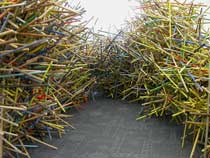
Brian Wagner’s “Accumulation” at Drexel’s Pearlstein Gallery is a long-overdue solo event for the found-object sculptor and Drexel prof. My quickie editor’s picks review is here. I can’t get enough of this work which subverts the utilitarianism of such tools as brooms and rulers to make them into metaphorical objects that tell tales of community and interconnections and time lines. Here I’ll run some images and say I have a soft spot for Wagner because he was the first artist’s feature story I wrote for PW back in 1999. I didn’t have a clue how to write a feature story and spent much time following Wagner around as he was putting together a show of his 5,000 Sticks. He was most generous and is a gentle soul.
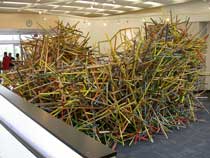
Top two images are the 5,000 Sticks here arranged in a kind of “u” shape at Drexel. Wagner had many assistants help him put together the piece. He said it took less than a day.
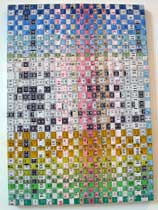
Woven tape measures…
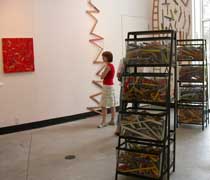
Sticks in vitrines and rulers on the walls. Also, a painting with stick imagery.
Summer of shovel love
artblog, May 27, 2004
post by Roberta
Libby told you about the Shovel show in her great post and I’ll not be redundant here, only mention I loved the show, too.
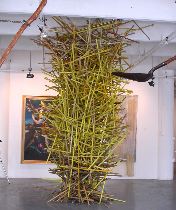
It was great to see Brian Wagner’s collection of sticks in the light of day once more. Wagner, who collects used broom and mop and shovel handles then occasionally hauls them out and stacks them — freely without armature or fasteners — in big haystack-like arrangements that tower in the air and miraculously don’t fall down, is one of Philadelphia’s many undersung art heroes.
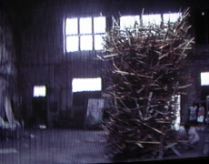
Wagner’s stack of 950 sticks — yellow as the summer sun — is culled from a greater assortment of some 5,000 the artist owns. I saw the 5,000-stick stack in a West Philadelphia trolley barn a few years back (1999 I think) and it was a wonder.
I wrote a story about Wagner, a Drexel prof, and his sticks for PW but unfortunately the paper’s online archives don’t go back that far so I can’t link it. Several videographers, including Highwire’s John Van Zandt, have videotaped Wagner’s sticks going up — usually a group activity requiring ladders and scaffolding. Van Zandt’s was playing on a video monitor in Highwire.
I have a copy of David Miller’s short video “5,000 Sticks,” which I played this morning for a stroll down memory lane. The image above is my photo of the last shot in Miller’s piece — it’s the completed stack in the West Philly shed. You can’t see it clearly but this thing had a tornado-like torque, it’s top seeming to spiral up and out for liftoff.
Digging it
artblog, May 24, 2004
post by Libby
Brian Wagner’s yellow version of his sticks-meet-gravity sculpture, stretches the shovel idea to tools with long handles. Suddenly, pushing the dirt with a mop or a broom seems not that different from shoveling.
Accumulations: The Art of Brian Wagner
Philadelphia Weekly, April 27, 2005
by Roberta Fallon
Brian Wagner, a gem of an underexposed local artist, is having a mini-retrospective at Drexel’s Leonard Pearlstein Gallery through May 5. The 59-year-old-whose freestanding broomstick accumulation 5,000 Sticks holds the fort in the gallery’s lobby-is a magician with found objects such as rulers, which he turns into metaphors for self-measurement. The same goes for sticks, which he turns into statements about community and labor. Wagner’s pieces are so simple they seem inevitable. Like the Slinky, the hula hoop and the yo-yo, the artist’s inventions feel as though they come from our collective subconscious. I met Wagner, an associate professor in Drexel’s design program, in ’99. A gentle soul with a quiet sense of humor and a found-object sculptor’s nose for good trash, Wagner lives amid his assemblages like a shaman with his totems. In this exhibit Blaise Tobia’s color photographs of the artist’s house give you a glimpse into his life. Wagner, who was beaming at his opening in a red jacket and red-and-white striped tie, is battling cancer. I hope his doctors can work some of their own magic on him.
One Man’s Kindling..
5,000 Sticks is more than just a bonfire waiting to happen
Philadelphia Weekly, Nov. 10, 1999
by Roberta Fallon
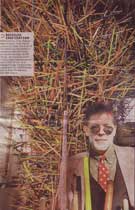
Some pairings are just meant to be. Pie and ice cream. Fred Astaire and Ginger Rogers. Brian Wagner and 5,000 Sticks. The 25-foot, 2-ton installation was built without the aid of fasteners by Wagner, an artist, collector and amateur archaeologist. Currently on display in an old Septa trolley barn in West Philadelphia, the free-standing work weds simple material (wooden sticks) with a simple, almost child-like idea. it looks like a haystack Leaning Tower of Pisa — a little scary and puzzling, yet somehow inevitable.
The sticks are from discarded brooms, shovels and mops Wagner has collected around Philadelphia for 10 years. He cuts the once-useful ends to match the factory ends. These over-size Pick-Up Sticks have a homey, beat-up look, and they boast some wacky colors — pink and green being the standouts. They also look like they’re ready for a bonfire, which is one reason the piece is indoors instead of outside.
A combination of gravity and over-and under-weaving of the layered sticks holds everything together. In a physics-as-art lesson, Wagner — an assistant professor in the College of Design Arts at Drexel University –explains that when the woven mound of sticks is around 75-strong, it gains so much weight that it might as well be a single object.
“It’s like a rigid 3-D weaving — really like a fiber,” he says. “It’s pretty strong.”
This is the eighth Wagner installation of its kind. His first, “Kablish 1,” at Rosemont College, was made up of 500 sticks. “‘Kablish'” refers to an accumulation of natural material pushed into a pile by floodwater of wind,” Wagner says. “It’s Celtic or Welsh, but I never did find it in a dictionary, so now I use numbers to name the pieces.”
Since then, Wagner has taken his wood work to Western Illinois University (2,000 sticks in 1996) and to Delaware State University (2,000 sticks in 1994). Two years ago, a group of 1,000 sticks found its way to Nexus in Old City. (Wagner was an early member of that artists’ cooperative.)
For the current installation, Wagner has chosen his most novel location. A formidable space, the trolley barn is owned by Michael Graves, an artist and friend of Wagner’s who hopes to continue using it as a place to show large art installations.
“5,000 Sticks” is more complex than the others,” Wagner says. “It’s the largest and the most ambitious — and the tallest. It has also been up the longest — since August 13.”
Wagner came through art school at the University of Pennsylvania during the minimalist ’70s. And he is especially into the ritual behind the work. The growth of the collection is a big thing, but so is the community of friends who collect sticks for him and participate in the building process.
“I’ve had children helping me, and college presidents,” says Wagner. “The 5,000 Sticks was built with the help of 12 friends and took two days to construct.”
Wagner used to be a painter. And even then, sticks were a kind of natural motif. There are stick-like marks or strokes in his layered, color field paintings from 18 years ago. “It was archaeological,” he points out. “Some of the paintings got pretty thick. But I was getting tired of painting, and thinking about how I could do this (layering) more three-dimensionally.”
Actually, the leap to the sticks was a pretty natural one — though it might not have seemed so at the time. A serious collector and certified amateur archaeologist who belongs to numerous local and regional archaeology societies, Wagner is an artist whose quest for materials has taken him far beyond the Home Depot.
That said, “5,000 Sticks” is not about recycling. It’s about history and tools, and the imprint of time and use. As one artist noted when he saw the work, it’s about the 10,000 hands that used the 5,000 sticks. “People ask why I don’t just get a grant and buy some new brooms,” Wagner says. “But I think the signs of use are significant.”
Wagner’s love of building and collecting goes back to his childhood. “My one grandfather was a carpenter and the other was a machinist,” he says. “And I was hammering away at age 4.”
Wagner’s personal collections — arrowheads, string, sticks, wooden rulers and yardsticks, glass jars and aquariums — sit side-by-side throughout his house, both as a display and a storage strategy. Lately, he has been playing with his rulers, using a Xerox transfer technique to create a whole new generation of subversive, evil-twin rulers, which look like the real thing but are totally dysfunctional. Yet beneath the playfulness, there’s an earnest quality to Wagner’s work that is endearing.
Sometime after the end of November, “5,000 Sticks” will be taken down, crated and stored until the next time. But Wagner will continue gathering, grouping and finishing discarded sticks. So feel free to bring him a few when you get the chance.
(top image is Wagner in 1999 in the photo for this article, bottom image is the photo as it appeared on the cover of the PW A and E section.)









